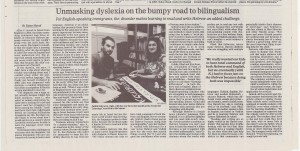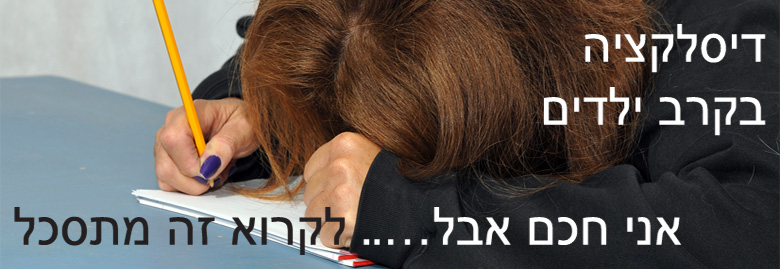After C. moved to Israel from England in 2006, the thirty-something immigrant took three ulpanim, or intensive Hebrew language courses, but just couldn’t grasp even the most basic Hebrew words. She began to consider that she might have a learning disability; after all, she struggled in school for years in England and never knew why. She always had menial secretarial jobs and could never aspire to more than that because she didn’t expect more out of herself.
In the ulpanim, she says, “I didn’t have a clue what the teacher was talking about and I couldn’t grasp either the written or the spoken language.” She finally got herself evaluated in 2009, and was diagnosed with dyslexia, a reading impairment that often accompanies difficulty writing unrelated to one’s IQ.
“The diagnosis was a huge relief, actually, because I didn’t feel dumb anymore,” says C., who asked to remain anonymous because she is looking for a job and doesn’t want her struggles to be known among her friends. I learned there was a real, valid reason behind my learning difficulties throughout my life. But then I really began to worry about how I would survive in a country where I would probably never learn the language let alone master it.”
Dyslexia provides challenges to everyone with the diagnosis, but among immigrants who are confronted with having to learn a new language, dyslexia is an added burden that prevents them from learning at the same pace as their peers, experts say. In many cases, the disorder is the root cause of social and behavioral problems in some children, because they lose self-confidence and have trouble integrating socially, says Judith Schwarcz, head of the Center for Learning Correction, which has offices in Ra’anana and Arad. Schwarcz is one of a host of dyslexia specialists throughout the country with particular expertise in working with bilingual children, many of them from English-speaking homes.
She immigrated to Israel 35 years ago from England and is dyslexic herself but went undiagnosed for years; it wasn’t until her son Yaron was diagnosed in Israel in the early 1990s that she realized that she, too, likely had dyslexia as well. “When I was a child in England there was still corporal punishment in the schools, so I was hit all the time and told I was lazy and stupid,” she recalls.
Dyslexia specialists interviewed for this article say that some immigrants and many immigrant children are only diagnosed with dyslexia after arriving in Israel because it isn’t until they have been faced with having to learn a new language and see they are failing to pick it up.
Dyslexia among immigrants is a double-shammy,”says A., an American in the center of the country whose 20-year-old daughter, K., has dyslexia, who asked for anonymity to keep her disability discrete. K. has lived her whole life in Israel but her Hebrew is still weaker than her English, the language spoken in their home, because the dyslexia made it harder for her to read and write with fluency. Her spoken Hebrew, like that of many native English-speakers with dyslexia, is fluent, however. “We really wanted our kids to have total command of both Hebrew and English, but we eventually [with K.] had to focus just on the Hebrew because doing both was impossible,” says her mother. K. worked with Schwarcz for a year on her Hebrew and “Judith gave her the tools that turned things around [for K.] and also gave her confidence after years of having none in her studies.”
Schwarcz uses the so-called Davis Method, which uses many visual methods to teach words, like using clay to make a “word picture” in order to learn a new word. But instructors use a variety of methods beyond Davis including techniques to simply calm down and not panic so as to work through difficult words, and hiding all the lines on a paper beneath the line that the student and teacher are working on because the mass of sentences can generate anxiety.
Goldie Gilad and Eve Resnick, co-founders of Point of Change who both live in Kfar Saba and are also certified in the Davis method, tutor children and adults with learning disabilities – though they prefer to call them “learning differences”- in both Hebrew and in English. Many of their clients are children from English-speaking families who are struggling in both languages, but often more so in Hebrew because theyi’ve grown up in English-speaking homes. Gilad and Resnick also tutor native Hebrew speakers with dyslexia who are struggling with English.
“Although Hebrew is a much more phonetic language than English, it is a different alphabet and you read right–to-left. Also, the vowels present a problem in Hebrew, because you don’t just have to learn the sound of a letter but have to put it together with the vowel underneath it, ”says Gilad. One middle-aged woman with dyslexia whom she works with prefers not to read any text with vowels, because they overwhelm her, says Gilad, while other English-speaking people with dyslexia are at a loss without them, because as English-speakers they can’t imagine a word without a built-in vowel.
Gilad, like Schwarcz, tutors many dyslexic Haredi children who are struggling with multiple languages: Yiddish, English, Hebrew and Lashon Hakodesh – ancient Hebrew, which has different vowel sounds and syntax- and Aramaic, used in Judaic texts. One Haredi boy she is working with is “on overload,” says Gilad, because his mother speaks to him in English, his father in Yiddish and he is learning Hebrew and Lashon Hakodesh in school.
“Reading and writing are so highly valued in the Haredi community that parents have trouble dealing with the fact that their children have a reading disability, yet they often don’t get help for them in school because a disability in that community can potentially hinder their chances of marrying”, says Schwarcz, who has clients in Mea Shearim and other Haredi areas. “But more and more Haredi parents are seeking help and dyslexia is slowly becoming less of a taboo, which is a great thing. After all, the most important thing is getting help for the child.”
Partners with Parents, a company in Ramat Bet Shemesh that helps children with learning disabilities and is run by a bevy of native English speakers, does bilingual reading assessments, offers a variety of tutoring services and even has a service to help potential immigrants and new immigrants find the appropriate schools for their children. The company explains to potential immigrants what their child is entitled to within the educational system, the logistics of school registration and application for services.
Indeed, all the parents and dyslexia experts interviewed for this article echoed a similar theme: Many schools aren’t sufficiently equipped to handle students with dyslexia, even when schools do test for learning disabilities. “We never imagined or expected that the schools would be able to help our girls. The teachers don’t have a clue and how could they have the time, with so many kids in the class?”, says one father, whose three children, all girls, have dyslexia or other learning disabilities. The youngest works with Eve Resnick. “From the beginning, we sought private help.”

Judith Schwarcz, right, with her son Yaron last month at the Center for Learning Correction in Ra’anana.







